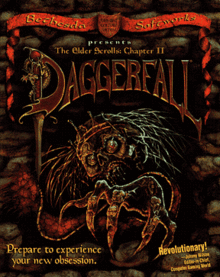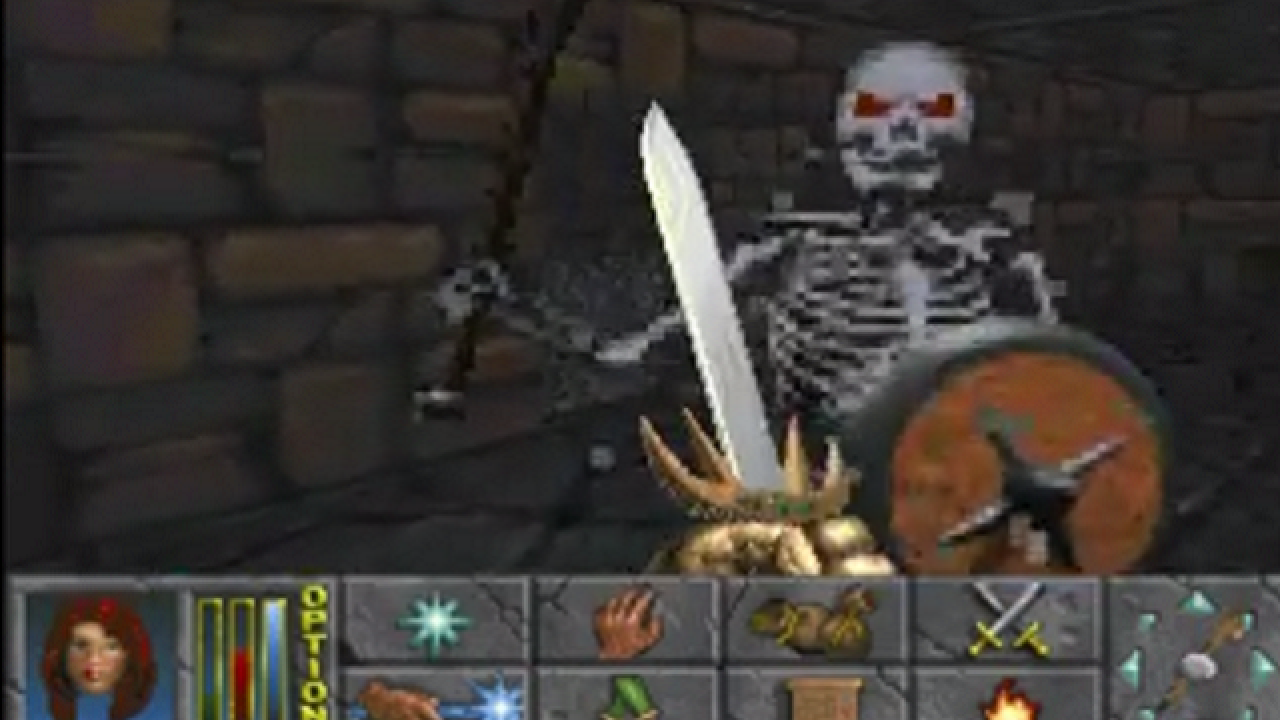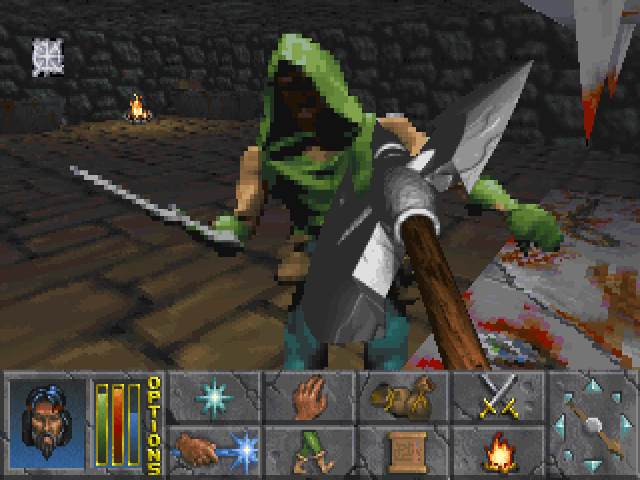Search
[{{{type}}}] {{{reason}}}
{{/data.error.root_cause}}{{{_source.title}}} {{#_source.showPrice}} {{{_source.displayPrice}}} {{/_source.showPrice}}
{{#_source.showLink}} {{/_source.showLink}} {{#_source.showDate}}{{{_source.displayDate}}}
{{/_source.showDate}}{{{_source.description}}}
{{#_source.additionalInfo}}{{#_source.additionalFields}} {{#title}} {{{label}}}: {{{title}}} {{/title}} {{/_source.additionalFields}}
{{/_source.additionalInfo}}- Details
- Category: Computer
- By Daniel Cullen
- Hits: 6837
The Elder Scrolls II: Daggerfall (PC)

The Elder Scrolls II: Daggerfall
Developed By: Bethesda Softworks
Published By: Bethesda Softworks
Released: September 20, 1996
Available On: MS-DOS
Genre: First-Person Action RPG
ESRB Rating: Mature
Number of Players: Singleplayer
Price: Freeware (was released by Bethesda in July 2009 into the public domain)
A wide-open world to explore is a common choice for many role-playing games, and if it can be done in such a way to immerse the player and not feel empty and lifeless, it can give the player a lot to do. In 1996, Bethesda Softworks tried to do this with The Elder Scrolls II: Daggerfall.
Daggerfall was the second game they made in a wide-open sandbox fashion, the first being its predecessor, Arena, which was in some ways more an experiment with this concept. Daggerfall is, in many respects, a much more refined means of attempting this type of game concept, using the XnGine, an early 3D engine that was all the more impressive for being tailored for DOS at the time.
The story is simple initially. Emperor Uriel Septim VII speaks with you in a dark room, charging you with putting to rest the spirit of King Lysandus, a loyal subject who died honorably yet cannot go to his grave in peace, and also asks you to find an embarrassing letter he wrote awhile back to the Queen of Daggerfall and destroy it since it never arrived as was intended. The story then snowballs quickly into a complex web of political and supernatural intrigue, and the decisions you make will not only shape the Iliac Bay area (the game setting) but will also shape history itself.
The gameplay is set in a first-person dungeon crawler style with action RPG controls, with swings of the mouse determining how your weapons move. Actions like jumping and climbing objects are also controlled similarly, and the keyboard serves as a hub of hotkeys to control such actions as talking to people, checking your inventory, and do such things as look at and interact with various objects.
On top of your assigned mission, there are a variety of organizations like the Fighters Guild, the Mages Guild, and various temples and Knightly Orders to serve. You can also do quests for certain people, indulge in theft and murder via the underworld guilds for those actions, and can even become a vampire or were-creature.
All of this takes place in a world where time passes and you have a reputation based on regional knowledge of your activities, so you must keep time limits for certain quests in mind as well as how regarded or despised you are, as this can affect future quests and how certain people interact with you.

Strong Points: Lots to explore; a wide variety of character builds; interesting and intriguing plot
Weak Points: Unintuitive controls; lots of bugs and instability; tedious dungeons; some features are completely broken
Moral Warnings: Intense violence with blood and gore; options to commit many unethical acts including murder and theft; lots of nudity with casual sex outside of marriage encouraged by frequent presence of prostitutes; ability to commit treason against all sorts of authority figures; main quest requires making many ethically gray decisions at best; necromancy and witch covens prominent, with the option to work for those who employ both; some crude language
The graphics are in a rudimentary form of 3D with a lot of 2D sprites. Given this game was made to run in DOS on the XnGine, this was impressive if somewhat blurry up close. There is a moderate degree of character animation and lighting given the 1996 era technology that existed at the time which was quite good for its time, yet the cramped interface and low resolution of practically everything is bound to look horrible on high-resolution monitors and does not scale very well at all.
Sound is a combination of MIDI based music and distinct sound effects for every character and action. The latter even serves a gameplay purpose, as a sharp ear in dungeons can help players pick up on nearby enemies. As to the former, it's quite good at setting the high fantasy mood the game is going for, though the tunes can get a bit repetitive.
Controls are keyboard and mouse-based, with or without an optional HUD display with the most common features clickable in a handy image format, like buttons for "look" or "grab." Combat involves swinging the mouse and clicking the attack button on the mouse in the desired direction, resulting in different attacks based on direction. The overall controls are a bit cumbersome, requiring the memorization of a lot of hotkeys on the keyboard and some tedious list searching, especially when navigating the magic menu. Overall, it's serviceable, but the control scheme is a far cry from simple and easy to learn, despite a very brief tutorial available at the very beginning of the game.
The difficulty is definitely on the hard side. How you create your character and work for your levels definitely will be important, as you have primary, major, and minor skills, and you must continually develop these to earn attributes points to boost stats. There are special advantages and disadvantages like rapid healing or phobias when encountering certain foes that can increase or decrease the difficulty of gaining levels as well if the player adds these. Finally, player race plays a role, some come with valuable resistances like High Elves, who are immune to paralysis, which can be deadly for a mass majority of the game.
Gameplay in general forces the player to be careful, as foes can attack at night everywhere, including civilized areas. Dungeons are even more dangerous as they not only have monsters, they also have traps that can be deadly when combined with the fauna you tangle with. Dungeons and some towns are massive, so map checking is an essential skill. All content save for story-specific areas is pre-generated and randomized, so while dungeons will be set into a certain form once accessed, their contents will change after every exit. Finally, certain weapons are useless against certain foes, and failure to plan can and will be fatal.

Higher is better
(10/10 is perfect)
Game Score - 62%
Gameplay - 13/20
Graphics - 7/10
Sound - 7/10
Stability - 1/5
Controls - 3/5
Morality Score - 4%
Violence - 0/10
Language - 2/10
Sexual Content - 0/10
Occult/Supernatural - 0/10
Cultural/Moral/Ethical - 0/10
Game stability is, to be frank, terrible. The stability of Daggerfall is so terrible the developers not only had to patch the game several times, they even had to release copies of the development tools so players could fix bugged save files. Crashes are frequent, and many game-breaking bugs exist. Certain features like the dodging code are either broken or not completely implemented, which can further drive players to frustration. Over a quarter of the magical effects are completely nonfunctional, and the reputation system of the game factions is notoriously complex and also has some bugs that can mess up save files. In short, do not go into this game expecting a smooth ride. The randomly generated dungeons feature is also incredibly buggy, resulting in some dungeons that are impossible to beat due to design errors in the procedural generation. The moral side of things is, again to be frank, terrible. This game has a lot of morally objectionable content, especially since it was released before formal rating requirements for many PC games and had a lot of content that would have earned it a modern-day mature or even adults-only rating. There is a "Child-Guard" feature to avoid spawning some monsters who show full female nudity, but it's effectively a tiny band-aid for a massive moral wound this game is scarred with.
Language is generally mild, the old English style of speech the game text goes for lends itself poorly to nothing other than a few mild expletives (like d*mn or h*ll). There are some crude sexual references, the game has a cut prostitution feature whose code remnants still exist in the dialogue of some characters, though thankfully this is not a common occurrence save for a few characters and rarely shows up unless you are deliberately looking for it. Some in-game books have some obscene material (that later games would have censored in-universe), including descriptions of frank sexual activity.
Sexual content, in general, is limited to explicit if very low-resolution nudity in some female character sprites, ranging from partial to complete nudity, though without any body parts in enough detail to be alarming aside from exposed breasts. Again, no actual sexual activity is explicitly shown or remains an option for the player, though the implications of the possibility still exist (there is a faction of scantily clad women in-game belonging to the Prostitute faction). However, they can only serve as sources of information or generic quest givers for the most part. Player models have a nude modeled "paper doll" in their inventory menu, and while somewhat cleaner than expected (no lower body parts are drawn in detail), it's still quite explicit from the waist up for female characters, and the Child-Guard feature does not prevent seeing this when changing equipment.
Violence is pretty graphic. Whenever something dies, it falls at your feet with a mix of entrails and blood mixed with its corpse, though the low resolution blunts some of the horrors, but not enough to be sure whatever died was killed messily. There is a faction of assassins one can join if they choose, and in all cases the deaths inflicted will be done for pay, and by the same token, enemies will be just as cold and merciless trying to strike you down, unless your language skills are high enough, which unlocks an option to walk past enemies peacefully unless you strike first.
Morally, the game's wide-open sandbox structure (in a world estimated to be the size of real-life Great Britain) allows for many unethical deeds. One may rob stores and homes of their goods, one can engage in murder, either for the assassins guild, freelance, or as a requirement for keeping one's powers as a vampire or werebeast in check should the player become one of those options. It's even entirely possible to betray political higherups, including the Emperor whom you serve as an official agent. The storyline involves necromancy (portrayed as evil, but you can work for those who practice it should you choose as well as being able to summon in-game demons called Daedra), court intrigue involving murders, larceny, and other foul acts of debauchery, and the player can choose to do a lot of work for witch covens, vampire clans, and be involved in sowing all sorts of discord committing various crimes on behalf of some quest givers. Conversely, it's possible to do moral acts like slaying monsters threatening innocent people, exorcising demons and ghosts, and doing civil service work like rescuing children from dungeons, but these options exist right alongside their less ethical counterparts. Further, even the most morally inclined player will have to make some ethically grey at best choices to proceed along with the main plot.
Even the "good" factions have some red flags. The game has a polytheistic religion, and since nudity and prostitution is prevalent in many of their temples (Especially Houses of Dibella), this will definitely repulse anyone offended by such themes for sure, even if it more accurate to the background lore (later games had to censor and retcon a lot of this due to ratings becoming more prevalent after this game released). While many of the deities espouse virtues such as hard work, charity, and other themes that are not all that offensive, some of the sketchier quests involve a lot of questionable ethics, such as constantly having to hunt down and kill apostates, though the game does emphasize said apostasy usually takes the form of consorting with necromancy or becoming a thug who preys on innocent people as a justification.
As a game, it was and remains very ambitious yet flawed, and while deserving of being called a classic, it has aged poorly and runs terribly on both DOS and DOSBox (which most modern users will run this under), and thus is not recommended save for a hardcore role-playing gamer or Elder Scrolls fan willing to accept this not a stable experience. In moral terms, it's a dark game full of a lot of violence, adult themes, and is not suitable for anyone who is not an adult, built-in Child-Guard feature or not.
Overall though, if you can accept the dark sides of the game's nigh legendary shoddy stability and the explicit nature of the violence and nudity prevalent within, Daggerfall does remain one of the most ambitious wide-open sandbox RPGs in the history of the genre and is worth playing at least once.
Modern players who want a more stable experience might also want to try running it via the Daggerfall Unity engine recreation, which does a lot to mimic the original engine while still preserving the classic feel but with the added stability and functionality of features missing in the original game.








